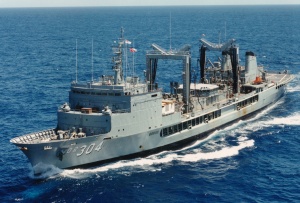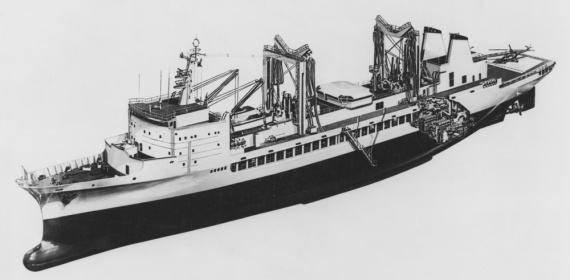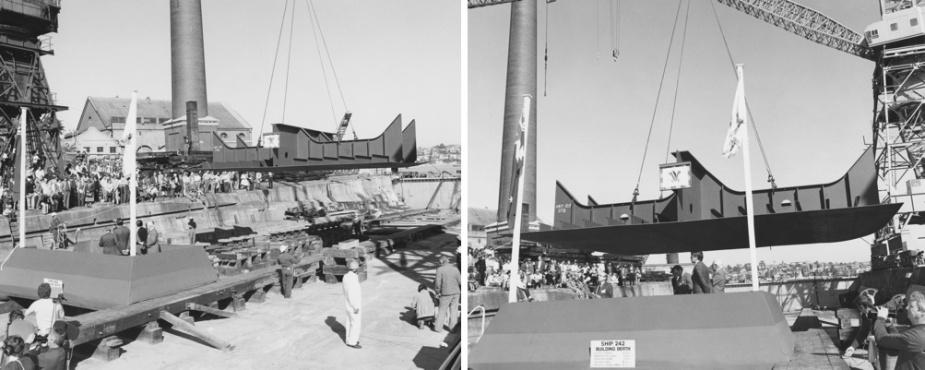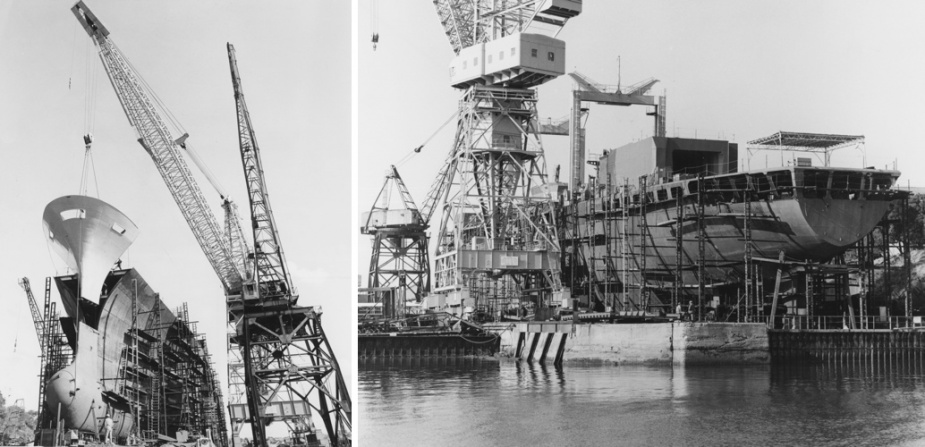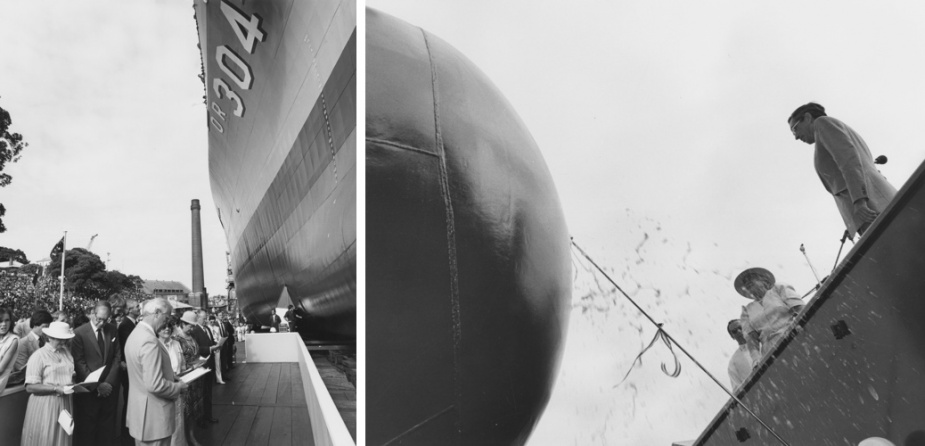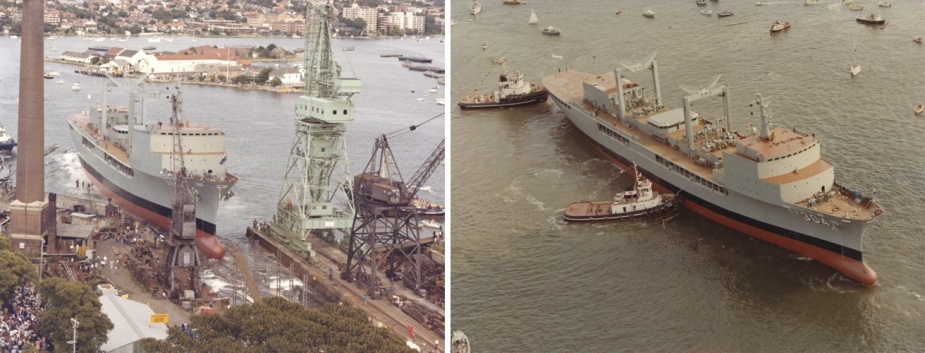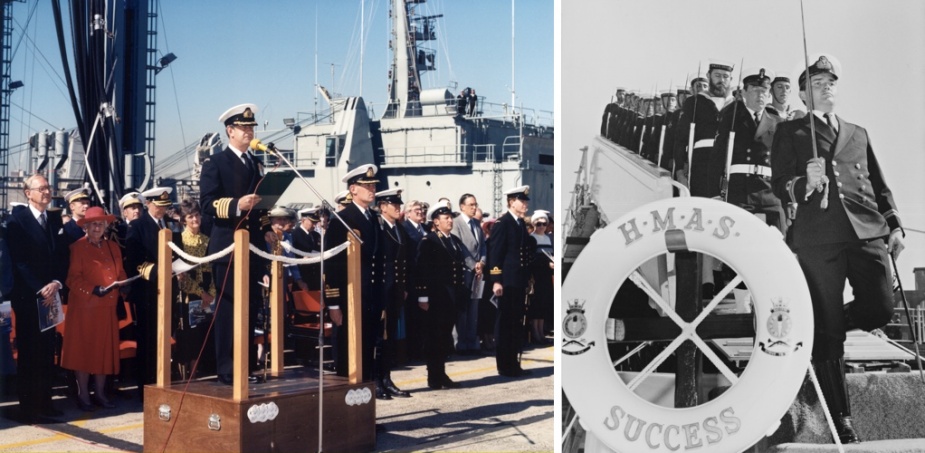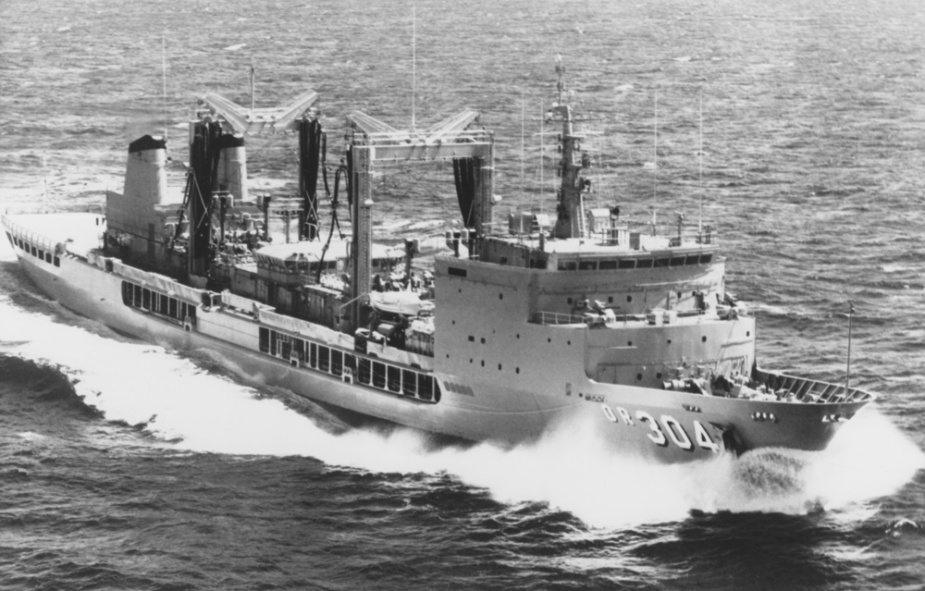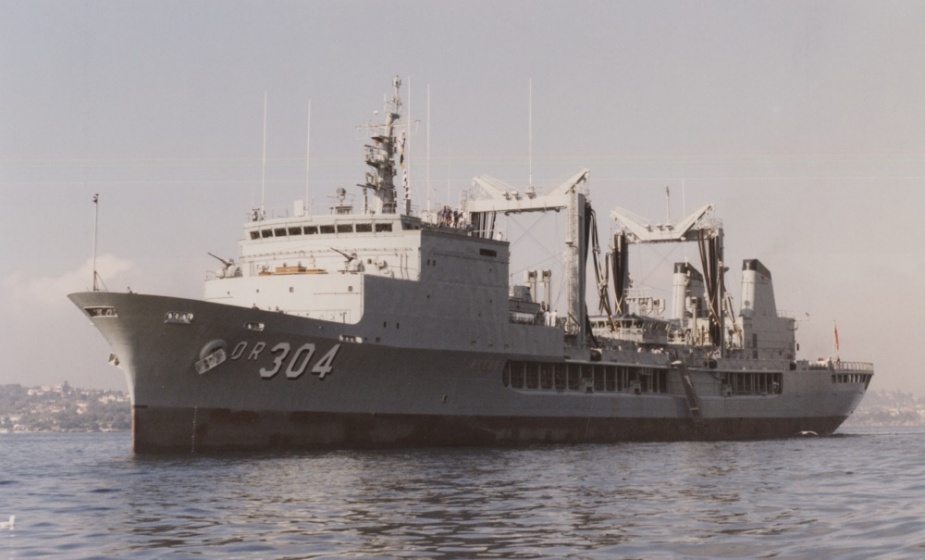HMAS Success (II)
| Type | |
|---|---|
| Role | Combat Logistics |
| Pennant |
OR304 |
| International Callsign |
VLNN |
| Motto |
Strive To Win |
| Builder |
Cockatoo Island Dockyard, Sydney, NSW |
| Laid Down |
9 August 1980 |
| Launched |
3 March 1984 |
| Launched by |
Her Excellency Lady Stephen, wife of the then Governor-General of Australia |
| Commissioned |
23 April 1986 |
| Decommissioned |
29 June 2019 |
| Dimensions & Displacement | |
| Displacement | 18,000 tonnes (full load) |
| Length | 157.2 metres |
| Beam | 21.2 metres |
| Draught | 8.6 metres |
| Performance | |
| Speed | 20 knots |
| Range | 8600 nautical miles |
| Complement | |
| Crew | 220 |
| Propulsion | |
| Machinery | 2 x SEMT-Pielstick 16 diesels |
| Armament | |
| Guns |
|
| Radars | 2 x Kelvin Hughes Type 100G |
| Helicopters |
|
| Awards | |
| Battle Honours | |
| Resources | |
| News Articles | |
| Image Gallery | |
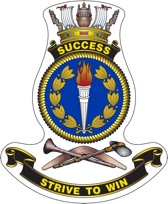
Plans for the acquisition of a replenishment ship for the Royal Australian Navy (RAN) may be traced back as far as June 1964 when the procurement of such a vessel was first put forward. The need for an underway replenishment capability to extend the endurance of RAN vessels had been recognised for some time given the vast areas over which the RAN operates. The fleet tanker HMAS Supply (I) had been in commission since August 1962 but had little capacity for the provision of bulk, dry stores. The acquisition of a replenishment ship was approved by Cabinet in November 1964 but was cancelled the following October as other projects took priority.
The Navy once again sought Cabinet approval for the construction of a replenishment ship, based on the hull design of HMAS Stalwart (II), in May 1969 at a cost of $42M. Cabinet approved the proposal on 22 July. Subsequently a Navy team visited the UK, US and Canada to examine certain aspects of the underway replenishment system. The team returned to Australia and recommended some amendments to the approved proposal including an increase in the ship’s length of 54 feet to accommodate an additional replenishment station.
A detailed design was developed ‘in-house’ by the RAN and completed in May 1972 with an amended cost of $61M. In light of the increased cost, the Department of Defence urged the Navy to consider a competitive tender process and even re-examine the requirement for the ship. Another submission was made to the relatively new Cabinet of the Whitlam Government in May 1973, and subsequently rejected. On 23 August, the Minister for Defence, Mr Lance Barnard MP, said, “We have decided that there is no need to proceed at this time with the construction of a fast combat support ship, capable of underway replenishment of the fleet. It has been assessed that such a ship would not be required before 1980, when HMAS Supply (I) is expected to be retired. I believe that a less sophisticated and less costly ship than that originally proposed at a cost now estimated at around $69M might be more suitable. This is being further examined”.
The Navy continued to examine options to acquire a replenishment vessel. A Military Movement and Support Group was established in March 1974 to investigate the need for both a heavy lift capability and an underway replenishment ship. Concurrently a Naval Scientific Service Underway Replenishment Study was initiated and its report, advocating the acquisition of an underway replenishment ship, was handed down that May. The Military Movement and Support Group submitted its report in November which also advocated for the acquisition of an underway replenishment ship for fuel and general stores, but put a lesser priority on armament stores in times of low threat.
In November 1974, meanwhile, the Navy succeeded in having an underway replenishment ship included in the 1975/80 Five Year Defence Programme at an estimated cost of $51M. The new proposal did not rule out an Australian build but acknowledged that only an overseas build would see the proposed ship replace Supply in 1980. In January 1975, 31 Australian and international shipbuilders were invited to register their interest. Eleven registrations were received. Based on those registrations, two companies, Rijn Schelde Verolme from the Netherlands and Direction Techniques des Construction Navales (DTCN) from France, were invited to tender for a project definition study based on an existing ship design that met most of the RAN’s requirements. Two Australian companies, Evans Deakin and Vickers Cockatoo Dockyard (VCD), were also invited to tender but later withdrew. In February 1977, DTCN was contracted to conduct the study based on the French Durance Class. The study was to include an investigation of the extent of possible Australian industry involvement including an Australian build with French design and support services. An RAN liaison officer arrived in France just days after the contract had been signed and remained there until June 1977. A permanent naval attaché commenced duty in Paris in March 1978.
Cabinet approval for the acquisition of an Auxiliary Oiler Replenishment (AOR) vessel was given in August 1977 at a cost of $73.2M under the assumption that the ship would be built by DTCN in France. However, when VCD failed to win the contract to build the RAN’s new Fremantle Class Patrol Boats in November 1977, the company lobbied the Government to be allowed to tender for the AOR. The Government agreed and both VCD and DTCN submitted their tenders in December 1978. The VCD tender was accepted the following August and a fixed-price contract to build the ship, to the value of $68.403M, was signed on 26 October 1979. SOFREXAN, a joint government and industry organisation established to facilitate the sale of French military and naval equipment to foreign governments, was contracted to supply construction documentation. More than 29,000 documents were to be provided.
Cockatoo Island Dockyard underwent a series of upgrades to enable the build to go ahead. A 50-ton Butters shipbuilding crane was obtained from the BHP shipyard in Whyalla and existing foundry buildings were converted into fabrication workshops. An existing plate-cutting machine was converted from photoelectric to computer control while the project also saw the introduction of Computer-Aided Drafting at the dockyard. A variety of other specialised equipment, such as new welding machines and lifting gear, were also purchased.
The final package of construction documents, excluding queries and requests for further information, was received by 28 July 1980 and VCD commenced laying the keel less than two weeks later, on 9 August. However, the translation of documents from French to English, coupled with differing production methods between France and Australia, proved to be somewhat problematic. The establishment of a Technical Assistance Group consisting of an engineer and two technicians, as well as a French-Australian Steering Committee, formed to address any major issues, did much to alleviate the problems.
1984-86
The ship was launched on 3 March 1984 by Her Excellency Lady Valerie Stephen, wife of the then Governor-General of Australia Sir Ninian Stephen, KG, AK, GCMG, GCVO, KBE, QC. Trials commenced alongside the Cruiser Wharf at Cockatoo Island the following month and contractor sea trials were conducted in November and December 1985. Contractor acceptance trials were conducted on 10 and 11 April 1986, and the ship was handed over to the Navy, at sea, on the 15th. HMAS Success (II) commissioned into the RAN at Pyrmont on 23 April 1986 under the command of Captain James Longden, RAN. She moved to Garden Island later in the month to make preparations for sea. Over 430 Australian companies had supplied equipment, material or sub-contract services to VCD over the construction period. She was the last ship built at Cockatoo Island.
HMAS Success (II) Commissioning Crew
| Captain JG Longden |
Commander DJ Ramsay |
Commander GH Stewart |
Commander PJ Glazier |
Lieutenant Commander TJ Stevenson |
| Lieutenant Commander BH Stewart |
Lieutenant Commander MR Traves-Taylor |
Lieutenant Commander WL Krause |
Lieutenant IR McGilvray |
Lieutenant MA Shelvey |
| Lieutenant AG Richards |
Lieutenant DR Maxwell |
Lieutenant P Weyling |
Lieutenant F Kresse |
Lieutenant M Hodgson |
| Lieutenant G Sydney |
Sub Lieutenant DJA Grove |
Sub Lieutenant AG Bodsworth |
Sub Lieutenant DA Waldie |
Sub Lieutenant DE Singleton |
| Sub Lieutenant CS Price |
Chief Petty Officer Coxswain MJ Monson |
Chief Petty Officer Quarter Master Gunner KC Ward |
Chief Petty Officer Marine Technician KJ Moyle |
Chief Petty Officer Marine Technician AJ Young |
| Chief Petty Officer Marine Technician JF Stokes |
Chief Petty Officer Marine Technician CB Flanagan |
Chief Petty Officer Electronics Technician GM Miller |
Chief Petty Officer Electronics Technician AJJ Vandyke |
Chief Petty Officer Writer JL Kent |
| Chief Petty Officer Stores Naval T Cant |
Chief Petty Officer Stores Victualler AR Hughes |
Chief Petty Officer Air Technical Weapons Electrical DE Lenatowski |
Petty Officer Quarter Master Gunner SR Van Prooyen |
Petty Officer Quarter Master Gunner MN Brown |
| Petty Officer Radar Plotter Batty |
Petty Officer Signals Yeoman NB Willoughby |
Petty Officer Radio Supervisor IC Picone |
Petty Officer Aviation Technician Aircraft PE Rosewarne |
Petty Officer Aviation Technician Aircraft DG Roach |
| Petty Officer Marine Technician LC Davis |
Petty Officer Marine Technician SM Logan |
Petty Officer Marine Technician HW McCullagh |
Petty Officer Marine Technician BP Rule |
Petty Officer Marine Technician CC Smith |
| Petty Officer Electronics Technician JE Tong |
Petty Officer Electronics Technician MD Summers |
Petty Officer Electronics Technician GD Wall |
Petty Officer Electronics Technician EM Wadner |
Petty Officer Electronics Technician GAH Wood |
| Petty Officer Cook PR Smith |
Petty Officer Steward A Larsen |
Petty Officer Medical DV Hodkinson |
Leading Seaman Physical Trainer KJ Bryant |
Leading Seaman Quarter Master Gunner JF Coubrough |
| Leading Seaman Quarter Master Gunner RJ Day |
Leading Seaman Quarter Master Gunner RAG Fleming |
Leading Seaman Quarter Master Gunner EJ Jarrett |
Leading Seaman Quarter Master Gunner MJ Moore |
Leading Seaman Quarter Master Gunner LC Saunders |
| Leading Seaman Coxswain JA Kelly |
Leading Seaman Fire Control IE Mundraby |
Leading Seaman Air Technical Weapons Electrical HC Holle |
Leading Seaman Radar Plotter DM Clearihan |
Leading Seaman Radar Plotter PM Koenig |
| Leading Seaman Radar Plotter WJ Ross |
Leading Seaman Signalman AG Culican |
Leading Seaman Marine Technician DJ Evans |
Leading Seaman Marine Technician GR Farrawell |
Leading Seaman Marine Technician GA Fiddes |
| Leading Seaman Marine Technician W Glazbrook |
Leading Seaman Marine Technician S Hentschell |
Leading Seaman Marine Technician ND Hughes |
Leading Seaman Marine Technician KD Johnston |
Leading Seaman Marine Technician WD Stach |
| Leading Seaman Marine Technician JL Keenan |
Leading Seaman Marine Technician RD Middap |
Leading Seaman Marine Technician KM Old |
Leading Seaman Marine Technician JC Robinson |
Leading Seaman Electronics Technician NJ Knight |
| Leading Seaman Electronics Technician KJ Owers |
Leading Seaman Electronics Technician TM Seidel |
Leading Seaman Electronics Technician BV Brown |
Leading Seaman Electronics Technician DJ Bunting |
Leading Seaman Electronics Technician AJ Burchill |
| Leading Seaman Electronics Technician NEJ Kingston |
Leading Seaman Writer GS Irwin |
Leading Seaman Stores Naval BJ Black |
Leading Seaman Stores Naval RW Dorian |
Leading Seaman Stores Victualler GJ Ladbrook |
| Leading Seaman Steward JJ Forster |
Leading Seaman Steward RW Herbener |
Leading Seaman Cook J McKenzie |
Leading Seaman Cook WR Wood |
Leading Seaman Air Technical Communications GP Brown |
| Leading Seaman Aircrew CR Young |
Leading Seaman Safety Equipment SJ Wacker |
Leading Seaman Safety Equipment SJ Wacker |
Able Seaman Quarter Master Gunner BH Best |
Able Seaman Quarter Master Gunner AB Bier |
| Able Seaman Quarter Master Gunner SP Davies |
Able Seaman Quarter Master Gunner RC Driffill |
Able Seaman Fire Control ME Blake |
Able Seaman Underwater Control DF Dyball |
Able Seaman Underwater Control PJ Elliot |
| Able Seaman Quarter Master Gunner CBM Hillsley |
Able Seaman Quarter Master Gunner NJ Kotaras |
Able Seaman Quarter Master Gunner RJ Kyle |
Able Seaman Quarter Master Gunner JC Lindsay |
Able Seaman Quarter Master Gunner AS Macgregor |
| Able Seaman Quarter Master Gunner MS Peek |
Able Seaman Quarter Master Gunner D Stopford |
Able Seaman Quarter Master Gunner MP Toohey |
Able Seaman Quarter Master Gunner SA Wilson |
Able Seaman Quarter Master Gunner JK Wyatt |
| Able Seaman Fire Control KS Ralston |
Able Seaman Fire Control M Sams |
Able Seaman Fire Control WM Soles |
Able Seaman Radar Plotter T Iliadis |
Able Seaman Radar Plotter NJ Kirkham |
| Able Seaman Radar Plotter PM McNicol |
Able Seaman Radar Plotter PF Mullins |
Able Seaman Radar Plotter MT Reynolds |
Able Seaman Radio Operator T Scott |
Able Seaman Radio Operator S Allen |
| Able Seaman Radio Operator IP Bradley |
Able Seaman Radio Operator NM Culpin |
Able Seaman Radio Operator GB Fullerton |
Able Seaman Radio Operator DM Hellier |
Able Seaman Radio Operator S Roach |
| Able Seaman Signalman BE Roberts |
Able Seaman Signalman SA Burcham |
Able Seaman Signalman PD Chapman |
Able Seaman Signalman CA Scott |
Able Seaman Signalman MI Gerrey |
| Able Seaman Signalman GT Nurse |
Able Seaman Signalman SC Zanker |
Able Seaman Fire Fighter BV Lawson |
Able Seaman Fire Fighter GW Small |
Able Seaman Meteorologist LA Thurgar |
| Able Seaman Marine Technician IG Arnott |
Able Seaman Marine Technician RH Bagrowski |
Able Seaman Marine Technician MC Baldock |
Able Seaman Marine Technician PA Bennett |
Able Seaman Marine Technician RA Bird |
| Able Seaman Marine Technician DP Burford |
Able Seaman Marine Technician KA Bushell |
Able Seaman Marine Technician SJ Cameron |
Able Seaman Marine Technician RA Dyer |
Able Seaman Marine Technician BW Fisher |
| Able Seaman Marine Technician MW Fulham |
Able Seaman Marine Technician PL Hennessy |
Able Seaman Marine Technician MJ Hodgson |
Able Seaman Marine Technician DJ Hoskin |
Able Seaman Marine Technician RG Hucker |
| Able Seaman Marine Technician WJ Keep |
Able Seaman Marine Technician JP Matthews |
Able Seaman Marine Technician JP Nikiforos |
Able Seaman Marine Technician GJ Preston |
Able Seaman Marine Technician JD Schwartz |
| Able Seaman Marine Technician MP Smith |
Able Seaman Marine Technician PC Ulrich |
Able Seaman Marine Technician MA West |
Able Seaman Electronics Technician BS Andrews |
Able Seaman Electronics Technician JF Askham |
| Able Seaman Electronics Technician NT Bateman |
Able Seaman Electronics Technician RA Chivers |
Able Seaman Electronics Technician RJ Clarke |
Able Seaman Electronics Technician WJ Comley |
Able Seaman Electronics Technician MJ Gun |
| Able Seaman Electronics Technician NA Odgaard |
Able Seaman Electronics Technician DA Rundle |
Able Seaman Electronics Technician DK Shortz |
Able Seaman Electronics Technician AM Wright |
Able Seaman Writer MP Bakker |
| Able Seaman Writer RJ Vermeer |
Able Seaman Stores Victualler RD Allen |
Able Seaman Stores Victualler BL Gibbons |
Able Seaman Stores Victualler DJ Gregory |
Able Seaman Stores Victualler PR Weir |
| Able Seaman Stores Naval SJ Getley |
Able Seaman Stores Naval MP Olson |
Able Seaman Stores Naval RA Steele |
Able Seaman Stores Naval RC Ward |
Able Seaman Cook GK Bexton |
| Able Seaman Cook GS Cole |
Able Seaman Cook AC Kenyon |
Able Seaman Cook NF Maher |
Able Seaman Steward SJ Chaplin |
Able Seaman Steward BM Neal |
| Able Seaman Steward SJ Taggart |
Able Seaman Steward RP Nish |
Able Seaman Steward GR Wright |
Able Seaman Dental SD Buck |
Able Seaman Medical CW Ryan |
| Able Seaman Air Technical Aircraft AT Hamilton |
Able Seaman Air Technical Communications WD Johnson |
Able Seaman Air Technical Aircraft IR Taylor |
Able Seaman Air Technical Weapons Electrical C Ranga |
Able Seaman Air Technical Weapons Electrical SB Wood |
The ensuing months was a busy period of trials, shakedown and workup exercises, and defect rectification common to brand new warships. Success put to sea for the first time as an RAN unit on 5 May to commence Sea Acceptance Trials. The trials included replenishment at sea trials conducted with HMA Ships Hobart (II) and Parramatta (III), gun-functioning trials and First of Class Flight Trials for Wessex helicopters. The ship was awarded interim clearance for day and night flying operations for both land-on and vertical replenishment by Wessex helicopters by the end of the month.
She visited Melbourne for the first time in June where she acted as host ship to US Ships Rathburne and Cimarron, and later conducted passage exercises with the two American warships en route to Jervis Bay. Later in the month she commenced an extended operability trial around Australia during which she visited HMAS Stirling, Fremantle and Darwin, and conducted numerous evolutions with a variety of RAN vessels, primarily HMA Ships Perth (II) and Canberra (II). She arrived back in Sydney on 25 July where a large amount of maintenance and defect rectification work was conducted over the ensuing four weeks. The opportunity was also taken to establish a strong relationship with the ship’s charity, the Mater Dei Children’s Home, as children and staff from the home visited the ship several times.
Success returned to sea on 21 August to recommence trials and exercises. After replenishment serials with HMA Ships Torrens (II) and Adelaide (II) that day, all major units in the RAN, with the exception of HMA Ships Brisbane (II) and Swan (III), had conducted replenishments from Success. She went on to visit Wollongong and also conducted her first missile transfer with HMAS Darwin on 26 August.
She participated in the Fleet Concentration Period in September before making a diplomatic visit to Vanuatu. She returned to Australian waters at the end of the month to rendezvous with the international fleet which was gathering for the International Fleet Review celebrating the 75th Anniversary of the granting of Royal Assent to the Royal Australian Navy. Success moved to her Fleet Review position at the Kirribilli Dolphins on 2 October, where she remained for the next five days, and a contingent of the ship’s company disembarked to participate in the anniversary march through the streets of Sydney.
The Fleet Review was conducted on 4 October by His Royal Highness, Prince Philip, the Duke of Edinburgh, embarked in HMAS Cook with Success the second ship to be passed on Cook’s route. The Duke embarked in Success that afternoon to attend a function in the Cargo Control Room before the ship participated in that evening’s fireworks display. She departed Kirribilli Dolphins on the 7th and proceeded to sea for de-ballasting and tank cleaning in preparation for post-delivery maintenance and defect rectification. She returned to Sydney Harbour on the 9th and entered Sutherland Dock at Cockatoo Island five days later. She undocked on 10 December and remained alongside at Sutherland Wharf progressing what was still a considerable work package. On the 12th the ship’s Wessex helicopter was used to transport Santa Claus to Camden to distribute presents to the children at Mater Dei Special School, an event which continued for many years and became a regular highlight in Success’ annual program.
1987
Success finally departed Cockatoo Island, with the Angels song ‘We Gotta Get Out Of This Place’ blasting over the ship’s broadcast, on 11 March 1987, and berthed at the North End Fitting Out Wharf where she commenced a week of harbour trials and safety inspections. She put to sea on 20 March to commence shakedown exercises and sea trials, during which she visited both Jervis Bay and Newcastle, and returned to Sydney on 3 April. The ship was formally accepted into full naval service on 10 April. The occasion was marked with a brief ceremony and buffet lunch on board. Success returned to sea on 21 April for work up exercises, and visited Melbourne towards the end of the month to participate in Anzac Day commemorations.
She participated in the Army exercise FLASHPOINT on 4 May and, two days later, a disaster relief exercise being conducted in Jervis Bay was interrupted by a real emergency. Jervis Bay police requested the assistance of the ship’s Wessex helicopter in rescuing a fisherman who had been washed off rocks in the vicinity of Governor’s Head. The fisherman was safely recovered within six minutes of the request being received on board.
Early in the morning of 20 May, while the ship was two days into a maintenance period alongside in Sydney, orders were received to prepare to sail to Fiji in support of Operation MORRIS DANCE, the Australian Defence Force’s response to the first of two military coups which occurred in the Pacific nation that year. Those crew members who had been granted leave were recalled and preparations for deployment commenced immediately. Two Wessex helicopters from 816 Squadron and a detachment from Clearance Diving Team One were embarked, along with personnel and vehicles from 104 Signal Squadron. It had been intended to embark 103 Signal Squadron, based in Townsville, but the squadron was unable to get to Sydney in time for departure. They were instead airlifted to Norfolk Island to rendezvous with the ship there.
Success departed Sydney for Fiji at 1330 on 21 May and two days later embarked the 103 Squadron contingent, stores and equipment at Norfolk Island as well as Commodore Malcolm Taylor, RAN, and his staff as the Officer in Tactical Command of the RAN Evacuation Task Group. The ship arrived just outside Fijian territorial waters on the 25th and commenced replenishment operations with HMA Ships Sydney (IV) and Parramatta (III), and HMNZS Canterbury, and transferred Army personnel to HMAS Stalwart. She conducted another personnel transfer with HMAS Tobruk (II) the following day, air-lifting 102 personnel and their equipment from Tobruk to Success. The transfer swelled the number of personnel embarked in Success to 292.
The presence of three Fremantle Class patrol boats (HMA Ships Cessnock (II), Townsville (II) and Wollongong (II)) brought about some Australian ingenuity as Success had not been designed for the replenishment of that class of vessel. On 26 May a failed attempt was made to refuel Wollongong abeam of the tanker using a modified crane rig based on a rig design successfully used by HMAS Stalwart (II). The following morning a second attempt was made by taking Wollongong in tow at slow speed and passing the fuelling hoses over the patrol boat’s bows from Success’ quarterdeck. While the refuelling rate was slow, the method worked and, coincidently, marked Success’ 100th replenishment at sea since commissioning.
By 29 May the situation ashore had stabilised to the point that the RAN force could begin to be reduced. That afternoon Commodore Taylor disembarked from Success and the replenishment vessel’s Commanding Officer, Captain Ralph Derbidge, MBE, RAN, assumed duties as the Officer in Tactical Command. Over the ensuing days all RAN units departed the area of operations; Success and Sydney were the last to leave on 2 June. The two ships arrived back in Sydney five days later. Disembarkation of Army personnel, vehicles and equipment took another three days before Success could recommence the maintenance period that had been interrupted two weeks earlier.
The ship returned to sea on 22 June to commence a seventeen week deployment of the South Pacific, South East Asia and Western Australia in company with HMAS Torrens (II). After completing her Operational Readiness Evaluation in Jervis Bay, and brief stops in Brisbane and Gladstone, Success participated in Exercise TASMAN LINK in the Shoalwater Bay Training Area from 3-5 July. Upon the completion of their TASMAN LINK commitments, Success and Torrens went on to visit ports in Nauru, Kiribati, Papua New Guinea where they rendezvoused with HMA Ships Canberra (II) and Hobart (II), the Philippines where HMAS Onslow joined the task group, and Hong Kong. The task group rendezvoused with HMNZ Ships Canterbury and Southland off Singapore as the group continued on towards Australian waters. On 25 August as Canterbury approached Success for a scheduled replenishment both of the tanker’s port and starboard steering systems failed leaving her drifting. The fault was quickly identified and power was restored to the port system but efforts to return power to the starboard system proved fruitless. The ship returned to Australia on just her port steering system and arrived at HMAS Stirling on 30 August where work commenced to fix her steering systems.
The defects were set right in time for the ship to participate in Fleet Concentration Period 87-2 and Exercise VALIANT USHER alongside US Navy (USN) units before returning home to Sydney on 25 September. Over the course of the deployment Success steamed 19,440nm, dispensed 79 tonnes of provisions, 23 tonnes of ammunition and 13,400m3 of F-76 diesoline fuel to 15 different ships from three nations. The excitement of returning home was quickly curtailed that evening, however, when the ship was placed on standby to return to Fiji following further political unrest in that country and the possible need to evacuate Australians bringing about a sense of déjà vu for the ship’s company. An amended maintenance period commenced while fuel and provisions were embarked, which would allow Success to put to sea quickly if required in Fiji. By 7 October the situation in Fiji had stabilised to point that RAN units on standby for deployment were stood down and Success’ maintenance period could resume as originally planned.
She crossed the Tasman Sea to visit Auckland and Wellington in November where a ship’s team of eight cyclists pedalled the 700km from Auckland to Wellington to raise money for the Mater Dei School. She returned to Sydney on 27 November concluding her third overseas deployment for the year and conducted two weeks of exercises in December before commencing Christmas leave.
1988
The New Year commenced with all the pomp and ceremony associated with bicentennial celebrations. Success was kept busy in the lead up to Australia Day conducting replenishment operations with the large fleet that had gathered to conduct the Bicentennial Fleet Entry and Review. She participated in the ceremonial Fleet Entry on 22 January, one of 15 RAN units led into Port Jackson by the flagship HMAS Stalwart (II), while the ship’s Wessex helicopter took part in a fly past of naval helicopters. Success remained alongside at Darling Harbour during the Fleet Review on Australia Day with some 200 guests of the ship’s company embarked to observe the festivities.
She recommenced a routine program of exercises, training and maintenance in February, which included participation in the first Fleet Concentration Period of the year that month. She took part in Exercise FLYING FISH alongside other RAN and French Navy units in March before visiting Melbourne for the Moomba Festival where a detachment of the ship’s company participated in the RAN’s Freedom of Entry parade on 14 March. She returned to Sydney on the 18th where she entered a leave and maintenance period, and commenced preparations for her first RIMPAC deployment.
The ship participated in Exercise TASMAN LINK in Queensland waters in early May. Later in the month a programmed maintenance period was interrupted for the third time in 13 months due to a potential requirement to evacuate Australian nationals due to civil unrest in a Pacific Island nation; on this occasion, Vanuatu. Success shortened her notice for sea to eight hours on 20 May under the auspices of Operation SAILCLOTH but was stood down four days later as the situation in Vanuatu stabilised. On the 26th she became the first Australian Defence Force unit to be fitted with a Global Positioning System (GPS) satellite navigation receiver, the day before departing Sydney for Hawaii, via American Samoa, in company with HMA Ships Hobart, Canberra, Parramatta and, after rendezvousing in American Samoa, Darwin.
RIMPAC exercises began on 24 June involving some 45 ships, 200 aircraft and 50,000 personnel, and continued until 19 July. The Australian task group departed Hawaii on the 26th and gradually dissipated as it crossed the South Pacific, each vessel taking separate routes back to Australia. Success arrived back in Sydney independently on 10 August and commenced a leave and maintenance period. Over the course of the RIMPAC deployment the ship had steamed 15,550nm and had conducted 83 replenishment evolutions.
Success returned to sea on 16 September and commenced of month of Bicentennial commitments. She proceeded to Brisbane where she took part in a series of receptions celebrating the Bicentennial including a march through the streets of the city to the World EXPO 88 site involving personnel from several international navies visiting Brisbane at the time and led by Success’ Executive Officer, Commander Charles Rex, RAN. She departed Brisbane on the 23rd and conducted passage exercises with KD SRI Indera Sakti and ITS Caio Duilio en route to Sydney where they joined the international armada assembling for the Bicentennial Naval Salute. She joined 30 other ships for a formation entry into Sydney Harbour on the 26th and a detachment of the ship’s company participated in a march through the streets of Sydney on the 29th. On 1 October she took part in the International Fleet Review which featured some 60 ships from 15 international navies. That morning the Duke and Duchess of York embarked in Success to conduct a royal levee on the ship’s flight deck, where they met representatives from each visiting naval contingent, before the royal couple, embarked in HMAS Cook, reviewed the fleet that afternoon. The event concluded following the evening’s fireworks display with Success’ ship’s boat deployed to rescue 18 people from Clarke Island after they had missed their transport back to the mainland. The opportunity was taken to conduct multi-national exercises upon the conclusion of bicentennial celebrations. Eighteen vessels from six foreign navies joined 11 RAN vessels for exercises off the New South Wales coast before the fleet disbanded and Success went on to visit Melbourne and Adelaide for further bicentennial commitments. She returned to Sydney on 27 October bringing her bicentennial commitments to an end. She recommenced a routine program of exercises, training and maintenance in November.
On 1 November a civilian Piper Navajo aircraft, performing a target-towing service under contract to the RAN, crashed into the sea while operating with Success south east of Sydney. Shortly before the crash the pilot has reported having engine problems but that he was alright. About a minute later he transmitted “I’ve got problems. Mayday. I’m going in”. No further transmissions were heard from the aircraft. Success initiated an immediate search and was shortly joined by HMAS Darwin which assumed the role of on scene commander. HMA Ships Canberra (II) and Parramatta (III), and HNLM Ships Jan Van Brakel and Kortenaer also joined the search along with numerous naval and civilian aircraft but, tragically, no trace of the aircraft or its three-person crew could be found. The search was curtailed the following afternoon and the RAN units were released by the Sydney Rescue Coordination Centre. Success returned to Jervis Bay before continuing fleet exercises. She commenced a leave maintenance period on 14 November.

